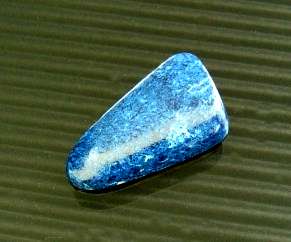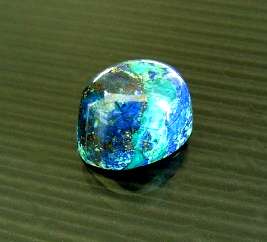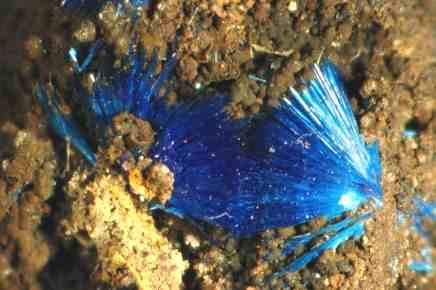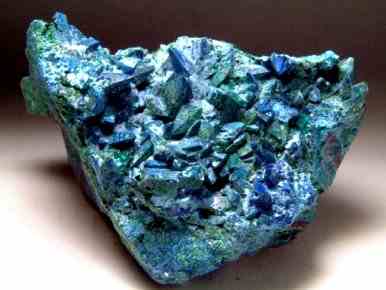 |
 |
| 宝飾用に研磨されたシャタック石(Polished
shattuckite
) 18.34ct(24x14x6mm) 16.09ct(17x12x12mm) | |
| Shattuck Mine, Bisbee, Arizona, U.S.A. | |
シャタック石(Shattuckite)
 |
 |
| 宝飾用に研磨されたシャタック石(Polished
shattuckite
) 18.34ct(24x14x6mm) 16.09ct(17x12x12mm) | |
| Shattuck Mine, Bisbee, Arizona, U.S.A. | |
| 化学組成 (Composition) |
結晶系 (Crystal System) |
モース硬度 (Hardness) |
比重 (Density) |
屈折率 (Refractive Index) | |
| シャタック石 (Shattackite) |
Cu5(SiO3)4(OH)2 | 斜方晶系 (Orthorhombic) |
31/2 |
3.8 - 4.1 | 1.752-815 |
| 孔雀石 (Malachite) |
Cu2(CO3)(OH)2 | 単斜晶系 (Monoclinic) |
3 1/2 - 4 | 3.8 | 1.66-91 |
| 藍銅鉱 (Azurite) |
Cu3(CO3)2(OH)2 | 単斜晶系 (Monoclinic) |
3 1/2 | 4.1 | 1.72-85 |
 |
 |
 |
| Shattuckite matrix
2.9x2.6x2.1cm Photo courtesy : Arken Stone |
シャタック石針状結晶の 球状集合体 9mm Shattuckite spherical sprays |
シャタック鉱と藍銅鉱の混合体 画面の幅 15mm Lab identified this specimen as a mixture of shattuckite and azurite - Field of view 15mm Bisbee, Warren Disrict, Mule Mts. Arizona, U.S.A. Bruce J. Murphy Collection |
| Mesopotamia, Khorixas, Namibia | ||
 |
 |
| 犬牙状の方解石結晶(1cm)に含まれるシャタック石 10x7x6cm Shattuckite included in scalenohedral calcite crystal(1cm) |
拡大写真 緑の結晶は翠銅鉱 Magnified view : green crystal is dioptase |
| Lubumbashi, Congo | |
| 写真提供(Photo coutesy) : Mineral Street | |
名前と産状(Name and occurence)
シャッタック石の名はこの鉱物が1914年に発見されたアリゾナ州、ビスビー地域の銅鉱山の名に因みます。
銅の酸化鉱地帯に二次鉱物として生成します。シャタック鉱山では孔雀石の仮晶として発見されました。
一般にこのような産状の鉱物は肉眼で見えるような結晶形を示すことは稀です。
多くは団塊状、時に針状、或いは針状結晶が集合した葡萄状として発見されます。
シャタック石は比較的に稀な鉱物ですが、ビスビー地域を初め、メキシコ、チリ、等々世界各地の主要な銅鉱山から報告されています。ただし量は極めて少ない。孔雀石の炭酸基が珪酸基に置き換わってシャタック石になるような条件は滅多なことでは整わないということでしょう。
最近ではナミビアのメソポタミア鉱山から繊維状、球状の美しい標本を時々見かけます。
上の写真、コンゴ産は犬牙状の結晶に驚かされましたが、実際には方解石の結晶に大量のシャタック石が含まれているものです。
稀な鉱物ではありますが美しい色合いのために宝飾用途に研磨されることがあります。
冒頭のカボションは20年以上昔に入手したシャタック鉱山産の研磨品です。
カタログの記述のみを頼りに、稀少鉱物という謳い文句と1個 6〜8ドルと格安の値段にもつられて正体不明の石を購入したものです。はやる心を抑えて包みを開けて見れば、藍銅鉱と孔雀石の混合物みたいな代物で大いに失望したものでした。
実際これは純粋なシャッタク石ではなく、藍銅鉱と孔雀石とが混ざったものに違いありません。
今日でこそインターネットでどのような鉱物でもたちどころに調べられますが、普通の鉱物事典には載っていないシャタック石の正体が分かったのは最近のことです。
かつては普通の鉱物事典に載ることのなかった鉱物のシャッタク石ですが、今ではGoogleで探せば117,000件も出ている時勢となりました。(もっともその殆どは抜群の霊的パワーを持つパワーストーン云々には笑わされます。ただの石ころなのにね)
The name of hattuckite derives from Shattkuckite mine, Bisbee, Arizona, U.S.A. where this mineral was first discovered in 1914, as pseudomorphs after malachite. It is a typical secondary mineral found in the oxidized zone of copper deposits. In general, minerals grown under such occurence rarely result in showing aparant crystal form, but are often found massive concretions of acicular or fibrous microcrystals. Although relatively rare mineral, shattuckite is reported from major copper mines in the world ; Bisbee, Arizona, Mexico, Chile, but with very few production. Probably, conditions to replace entire carbonate group of malachite by silicate group to form shattuckite would hardly happen in the nature. Recently beautiful specimen with spherules or sprays of acicular radial crystals are seen from Mesopotamia, Copper Valley of Namibia.
Shattuckite is, although rare, sometimes polished for ornamental purpose, thanks to beautiful color. Polished shattuckites on the top photo are from Shattuck mine, which I purchased for over 20 years ago through mail order, without knowing anything about this mineal. A pamphlet without photo said this stone extremely rare with attractive price of US$6 to 8 per stone. Despite great expectation, two colorful stones appeared frompost parcel looked like a mixture of malachite and azurite and not attracted at all.
Today, we are able to access to Google search to find more than 117,000 articles on such rare mineral of shattuckite.
ビスビー鉱山について (About Bisbee Mines)
藍銅鉱(Azurite) 7x4cm
Bisbee Mine
David Eidahl Collection孔雀石ー藍銅鉱(Malachite-Azurite)7cm
Copper Queen Mine, Bisbee, Arizona, U.S.A.
William Larson Collection
アメリカ、アリゾナ州にはMammoth, Tiger, Collins, Mohawk, Red Clouds, Ajo, Bagdad, Morenci, Globe, Lay, San Manuel 等々世界で有数の金、銀、銅, 鉛、亜鉛、モリブデンの重金属鉱山があります。
これらの鉱山から産する見事な、そして稀な鉱物結晶の数々は世界の鉱物収集家の垂涎の的でありました。
砂漠の中の辺境の町のツーソンで毎年世界最大の鉱物と宝石のショーが開催されるのは、元を辿れば、これらの鉱山に囲まれたツーソンの町の鉱物コレクターの標本交換会に端を発します。
そして世界の銅鉱山の中でも最大級であったビスビー地域はツーソンの南東80kmのメキシコ国境沿いにあります。
1877年の夏にミュール山脈の渓谷で豊穣な銀と銅の露頭が発見されたビスビー鉱山は、その後1930年初頭まで Czar, Cole, Sacramento, Dallas, Campbell, Shattuck, Irish Mag, Silver Spray, Keystone, そして Copper Queen と、次々に新たな鉱区が開発され、露天掘りと地下の数百kmに達するトンネルによる採掘は1975に閉鎖されるまでのほぼ一世紀に及ぶ活動で総額60億ドルを越える金属を産出しました。
Arizona is rich in world famous ores of gold, silver, copper, zinc, lead, molybdenum from Mammoth, Tiger, Collins, Mohawk, Red Clouds, Ajo, Bagdad, Morenci, Globe, Lay, San Manuel mines etc. Superb and exotic mineral specimens, mined from these veins have been eargerly sought after mineral collectors of the world. It is not strange why in Tucson, a frontier city in the desert became the world famous gem & mineral show locality. A local mineral specimen exchange circle of Tucson, which is located in the midst of these mines, was the start of the Tucson Show, which has grown to be the the largest gem and mineral show in the world, today.
One of the greatest copper camps on earth, Bisbee, located 80km south east from Tucson, near Mexican boarder, was discovered in early 1880's with rich silver and copper outcrops in a desolate Mule Mtns. canyon. By early 1930's, new mines have been exploited one after another ; Czar, Cole, Sacramento, Dallas, Campbell, Shattuck, irish Mag, Silver Spray, Keystone and Copper Queen mines, to produce over U$6 billion in metals until the last operation was ceased in 1975 through many hundred kilometers of tunnels and open pit mining.
Top Gemhall